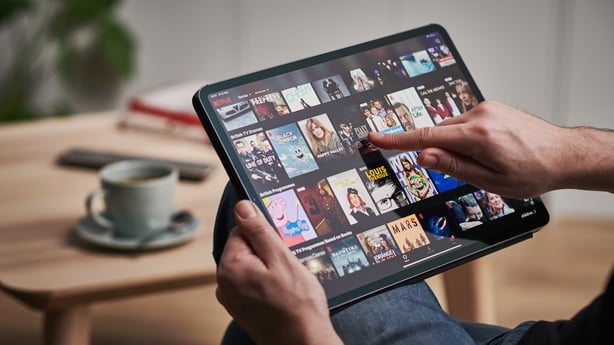When Netflix launched in Ireland in 2012, it brought what was a relatively novel business model to these shores; consumers paid a (small) monthly fee for unlimited access to its digital catalogue of films and TV shows.
More than a decade on, though, subscription services are an every day part of our spending habits.
How big are digital subscriptions now?
We need your consent to load this rte-player contentWe use rte-player to manage extra content that can set cookies on your device and collect data about your activity. Please review their details and accept them to load the content.Manage Preferences
A survey published by the Central Statistics Office at the end of last year found that 44% of males had been subscribed to a video streaming within the previous three months.
The figure was 42% for females.
That covers people aged 16 and over and it's worth bearing in mind that subscriptions are often shared between multiple people in a household.
The actual percentage of the population using a video streaming service at any time would probably be considerably higher.
A similar proportion of males also subscribed to a music streaming service – while it was 39% of females.
But subscriptions are now about far more than video and music.
Today there are subscription services for meals, fitness plans, newspapers, meditation tips, make-up, coffee, perfumes and whiskey.
Pretty much any product or service you want can be acquired via a subscription service.
What does 'background spending’ mean?

This is the term that’s been coined to describe how so many of us treat subscription services.
We sign up to these things – maybe even on a free trial – and then we forget all about them.
And because they each only cost a few euro each a month, it can be easy to miss that going out of your account.
In fact it's likely that most people don’t know what they’re spending on subscriptions.
Perhaps they signed up a long time ago and have forgotten the monthly cost – or maybe the missed the email that told them the price was about to go up.
It’s also possible that they’ve just completely forgotten that they’re signed up in the first place.
And because it’s a small monthly fee it kind of lulls us into feeling like it’s cheap – but of course, it adds up very quickly.
It’s kind of like when you go into a cheap clothes shop and you keep spotting bargains. But it’s only when you get to the till that you realise you’ve put €100 worth of cheap ‘bits’ into your basket.
Let’s imagine what would be a common set up for a household today – where there’s a standard Netflix subscription, along with accounts for Disney+ and Spotify Premium.
That’s €15 a month for Netflix, €11 for Disney, and another €11 for Spotify.
Put that together, and you’re looking at €37 a month – or €444 a year.
That’s more than a lot of people would pay for their mobile – or their traditional TV service, or even home broadband.
And if you add in another service or two, say costing another tenner a month, suddenly you’re paying €47 a month or €564 a year.
And if you multiply that across every household in the country…
Exactly… it translates to a lot of money…
A survey by Censuswide back in August indicated that Irish consumers would spend a combined €1.3 billion on video streaming alone this year.
So that doesn’t include music, meditation apps, nutrition plans, or whatever else.
And that figure is 34% higher in just two years.
How come it’s risen so sharply?

Part of the reason is simply because the cost of subscription services – particularly video streaming services - has gone up.
In early 2021, the standard Netflix plan was €13 per month – now it’s €15. That’s a 15% increase on its own.
At the start of 2021, Disney Plus cost €7 a month in Ireland – now it’s €11 a month. That’s a 57% increase in two years.
But another factor is the explosion in the number of services available.
Even in video streaming itself - while you would have started out with Netflix, and then Amazon Prime, and eventually Disney Plus… now you also have Apple TV, Peacock, Paramount Plus, Now TV, Discovery Plus.. and a few others.
So if people decide to add even one of those to the services they already have, that’s going to represent a significant increase in their subscription spending.
But the key question is – are they worth it?

Well that is subjective, of course…
Few would argue that they’re getting less value from their video streaming services now than they were a few years ago.
Netflix launched in Ireland in 2012 – and at the time it cost just €7 a month.
It also came with a huge catalogue of great content.
But the only reason they had that was because major TV and film studios didn’t care about streaming – once they say there was money to be made, though, that changed.
Now so much of that good content has been pulled from Netflix and put onto studios’ own streaming platforms.
That means that to get the same content you need to subscribe to multiple services – maybe costing €5-10 a piece.
At the same time Netflix’s price has risen, and they’ve stopped password sharing, so it’s harder to share the cost with others.
And while Netflix have tried to fill their catalogue with their own content to replace all of the stuff the studios took back – it’s fair to say that the quality hasn’t been nearly as consistent as it once was.
So why do we keep paying for them?
A survey by PwC published back in July found that Irish consumers liked the convenience and cost-effectiveness of subscription services.
You can read into that and see how we get reeled into these services.
Because, in terms of cost-effectiveness, a couple of euro a month for access to loads of films and TV shows seems like a good deal in theory.
But what’s harder to measure is how much use you’re getting out of each service.
If people sat down and worked out how many minutes or hours of entertainment they got from a service – and so how much they paid per minute, say – they might not see it as quite a cost-effective.
If they got their subscription service bill in one annual hit – rather than spread out over the month – they might also think twice about paying for it.
So why don’t we cancel them more often?

This kind of goes to the ‘convenience’ thing that people talk about. Because signing up and using a service probably is quite convenient… but walking away isn’t always.
A very real problem is that we simply forget we’re paying for it.
There’s also a ‘fear of missing out’ element too - you don’t want to be the only one who didn’t get into the next big thing on the ground floor.
But even when we make the decision to cancel, even the thought of having to log on and go through the cancellation process is enough to put anyone off, and we assume it’s going to be made difficult for us.
And in some cases it is – signing up can be done with the push of a button, but cancelling requires phone calls and a battle with customer services.
The new Digital Services Act from the European Union does aim to make it so that service providers have to make cancelling as easy as signing up in the first place, but whether that will become a reality, and how it will be enforced, remains to be seen.
So how can we make sure we’re getting good value for money?
Well the first thing you need to do is look at what you’re subscribing to – knowing is the first step.
So think of all the subscription service you’ve used in the past – the video ones, the audio, the ‘boxes’ that get delivered, maybe the monthly payment you make to an artist or creator you like through the likes of Patreon.
And just because you haven’t used the service in a while, doesn’t mean they’re not still taking money from your bank account.
Doing that might be tricky.
If you subscribe to services through apps you might find some of them listed in your App Store or Play Store account, which can simplify the process.
But if you’ve signed up yourself, you may have to trawl through your emails and bank account statements.
But it’s worth doing.
And if there are multiple adults in your household – maybe get them to do the same.
Because, while you’re not supposed to share accounts with others, it is fine for you to share one within the same household.
So if you find out that more than one of you is subscribing to the same service, you can cancel one but still keep access.
Some providers – particularly the music ones – also have ‘family’ plans that allow up to six people on the one account.
Apple Music, for example, costs €17 a month for a family – compared to €11 a month for an individual… so even if that’s split across two people, it’s immediately a saving.
And once you know what you’re spending, what should you do?

Really at that stage it’s about being honest with yourself.
What services are you using, and what ones are you paying for but not getting your money’s worth out of.
What ones would you hardly miss if it were to disappear tomorrow?
And the beauty of streaming services is that they’re paid on a monthly basis – which you can use to your advantage.
As you’re not tied into a long-term contract, you can walk away immediately… but you can also come back at any stage.
There’s nothing stopping you from cancelling one now – and signing back up if you realise you do miss it… or if something comes along that you’re interested in.
In fact it’s increasingly common for people to ‘cycle’ their subscriptions, so they sign up to one for a month, blitz through the things they’re interested in, and then cancel and switch over to another service, doing the same there, and moving on.
Or they’ll regularly unsubscribe, or threaten to unsubscribe, knowing that they’ll get a discount offer to keep them interested.
And that might be the thing that suddenly makes that service good value for you once again.





